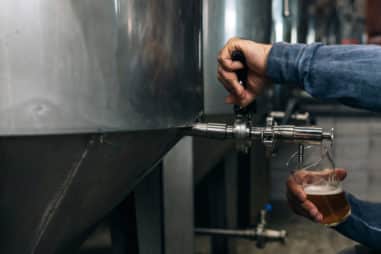Sediment is harmless.
For some homebrewers, they prefer to remove as much sediment as possible from their beer.
Others drink it because it has a lot of Vitamin B. Who knew, right?
But what’s the best way to treat sediment in beer? Honestly, the answer would be to just let the yeast do its thing.
Now, that might be acceptable for every beer drinker. For others, not so much. So, this guide is fully prepared to give you the answers you need.
Does Beer Have Sediment?
Most beer will have sediment. Even a large commercial brewery like Sierra Nevada has beer with sediment in it.
Any bottle-conditioned beer will have sediment in it. It’s unavoidable.
You need yeast and sugar for carbonation to take place. Even if you force carbonate CO2, there’s still the transfer process.
Like when you siphon beer from your primary vessel to your bottling bucket.
If you’re not careful enough, you might end up collecting some sediment. And that inevitably ends up in your beer.
Does Unfiltered Beer Have Sediment?
Unfiltered beer has sediment, and here’s why:
First, you need to understand what filtration does to beer.
Beer is filtered to produce beer with more clarity. And to do that, you have to remove sediment from your beer.
So, what do you think unfiltered beer is like? Well…it’s the opposite!
Unfiltered beer doesn’t undergo extra filtration before packaging. That means the yeast particles are intentionally left behind.
The result? You get a beer with more flavors and aromas! And also, sediment.
What Is Sediment in Craft Beer?
Sediment in craft beer is mostly yeast. Some will have hop particles too.
Why does craft beer have sediment?
It’s because of secondary fermentation. Technically, there’s active yeast eating sugar in the can or bottle to create carbonation.
After the yeast has done its job, it will eventually settle to the bottom of your beer.
If you agitate the beer or can, the sediment will be suspended in beer for a time. And after letting it rest, it settles back down to the bottom.
The same also goes for IPAs. Because IPAs require a ton of hops, you’ll also see protein particles in your beer.
And finally, other IPAs like a NEIPA, for example, are unfiltered. Combine that with the massive amount of hops and it’s inevitable you’ll get sediment.
However, there’s a fancier term for these particles you see in a NEIPA. It’s called colloidal haze.
What Is the Sediment in IPA Beer?
The sediment you see in IPA beer is yeast and protein particles.
This could also be the protein-polyphenol bond formed during the brewing process.
See – some IPAs will use a lot of grains in the brewing process. One example of that is a New England IPA.
The protein found in those grains will then combine with the polyphenols in hops. And the result is a colloidal haze or particles that give a NEIPA its hazy or cloudy appearance.
What Is the Sediment in Unfiltered Beer?
The sediment in unfiltered beer is yeast particles.
Because unfiltered beer does not undergo extra filtration, the yeast particles remain in the beer.
Now, why do brewers choose to not filter their beer?
Mainly to preserve more of the flavor and aroma in beer. Unfiltered beers will have more complex flavors and aromas than filtered beer.
In addition, unfiltered beer will have a softer mouthfeel.
However, the main downside is that it shortens the shelf life of beer.
Is There Sediment in Wheat Beer?
Wheat beer will have sediment. And that’s actually not surprising since wheat beer uses a lot of wheat.
This also gives wheat beer its cloudy and somewhat hazy appearance.
For example, Belgian witbiers and German hefeweizens will have sediment. The sediment in these beers are composed of two ingredients:
- Yeast
- Barley protein
Can You Remove Sediment in Wheat Beer?
It’s not a good idea to remove sediment from wheat beer. And that’s because sediment makes up a significant flavor component in wheat beers.
Yeah, no kidding.
You won’t be able to taste the full flavor of a wheat beer if you remove the sediment. By removing the sediment in wheat beer, you intentionally remove the spice and wheat flavor too.
Basically, you have to rouse your wheat beer so you get the full flavor package. It’s only achievable with the sediment.
In fact, there’s a proper way to pour a wheat beer so you get the sediment in your glass.
Here’s how to do it:
- First, grab the bottle and rouse it a bit. Don’t shake it. Be careful not to rouse it too aggressively.
- Simply let the bottle rest sideways on your palm.
- Gently rotate the beer while the bottle is resting on your palm.
- Open the bottle cap of your wheat beer.
- Grab your glass and tilt it to about 45 degrees.
- Gently pour your wheat beer along the side of your glass.
It’s worth noting that a Weizen glass is the best glass to use for a wheat beer. Why? Because if your glass is too small, you’ll have about 1 to 2 ounces left in your bottle.
If that happens, you won’t be able to get all the sediment in your glass either.
Is It Normal for Beer to Have Sediment?
It’s completely normal for beer to have sediment. It’s a natural trait due to the yeast added for bottle conditioning.
Some beer styles intentionally leave yeast behind as a flavor component.
And then there’s unfiltered beer. When brewers don’t filter beer, yeast and protein particles remain in your beer.
For unfiltered beer styles, it’s necessary to achieve a hazy appearance and preserve more flavor and aroma.
Should There Always Be Sediment in Beer?
Not necessarily. There doesn’t have to be sediment in beer.
In fact, a lot of breweries don’t intentionally want to leave sediment in beer. It simply happens as a result of the yeast during bottle conditioning.
For Trappist ales that undergo secondary fermentation, part of their brewing process is to add yeast and sugar prior to packaging.
What are you thinking? If only beer could be yeast-free?
But that would make beer taste flat!
Unless you have fancy equipment to filter all the sediment in your beer, that’s one way of having a sediment-free beer.
Other methods like using an in-line filter or fining agents are another way to reduce sediment.
But generally, any bottle-conditioned beer will have sediment or small traces of sediment.
Why Does My Beer Have Sediment?
You added yeast, didn’t you?
And you need the yeast so that it can eat your sugar and carbonate your beer.
Or wait – what’s your recipe? Is it an IPA? A NEIPA, perhaps?
Then you’re bound to have sediment too.
Sediment is mostly yeast particles. But for other beer styles like an IPA that use a lot of hops, well…
That means your sediment is mostly yeast and protein particles.
NEIPAs are also unfiltered, so you can’t exactly filter a NEIPA and turn it into crystal clear beer. It wouldn’t be a NEIPA anymore!
Or how about this.
You probably used an auto-siphon to siphon out your beer from your fermenter to your bottling bucket.
You even got a racking cane to help you out!
But, even one misstep can lead to siphoning small traces of sediment into your bottling bucket.
Yes – it takes practice, discipline, and patience. A whole ton of it.
The only way for your beer not to have sediment apart from filtration is to remove the yeast itself.
Now that would be crazy, though, right?!
Removing yeast would wreck the flavor of your beer. Let alone, you’d have to add an additional step of force-carbonating your beer.
Why Is There Sediment in My IPA?
IPAs are no different. Heavily dry hopped IPAs will have yeast and protein particles.
Think of it this way.
Have you ever seen or tried wheat beer? Do you notice its cloudy appearance?
You obviously see the sediment, right?
That’s not just yeast. That’s also barley protein. Because wheat beers use a ton of wheat, the protein particles in the wheat also become sediment in your beer.
Yes – it’s unavoidable for IPA styles like New England IPAs, East Coast IPAs, and so on. For a West Coast IPA though, well, it doesn’t have sediment because it was filtered.
As mentioned earlier, you can’t compare the filtration system of a homebrewer and a commercial brewery.
The filtration systems are different. Vastly different.
A commercial brewery’s filtration system allows them to brew crystal clear beer. However, it’s not that you can’t homebrew a crystal clear beer.
With kegging, it’s very possible. And with the right equipment and tools, it’s possible too. But this takes practice.
Even something as simple as say, for instance…
Transferring beer from your primary fermenter to your secondary fermenter. That takes a good amount of practice.
Most homebrewers will start at the bottom of the fermenter. But this leads to eventually collecting sediment. It’s better to start at the middle then slowly lower your siphon as the beer level lowers.
And just when you’re an inch away from the bottom of your fermenter, tip your fermenter or carboy.
But do it gently. By tipping your carboy, it’s easier to collect all the liquid without accidentally collecting a lot of sediment.
Now, what’s the point of explaining this process?
For starters, this is a mistake most first-time brewers make and it eventually leads to having sediment in their beer.
For IPAs, it ultimately depends on the recipe. You can’t avoid sediment for a NEIPA, Hazy IPA, or East Coast IPA.
What Causes Sediment in Beer?
Now, that’s a great question! There are several causes for sediment in beer.
You’re already aware that bottle conditioning is one of them, but what about the others?
First, a quick explanation on bottle conditioning again.
How Does Bottle Conditioning Cause Sediment in Beer?
Bottle conditioning is the process of deliberately adding yeast to the bottle before capping/sealing it. Sometimes, brewers will also add sugar or maltose.
What happens essentially is that a mild fermentation will take place in the bottle.
This is also necessary to create carbonation in beer and slightly increase the ABV (alcohol by volume).
After the yeast has done its work, it’s not like you can open the bottle cap and filter the yeast out.
That’s like throwing away great beer!
As a result, the yeast will settle to the bottom of the beer bottle known as sediment. If the bottle is agitated, the yeast particles are released back into suspension.
If the bottle is allowed to rest in an upright position for a time, the sediment will settle to the bottom eventually.
Why Does Aged Beer Have Sediment?
Aged beer will have sediment because it’s just plain old.
Old as in it’s probably expired.
But what you see isn’t yeast particles. You’re already aware that age can destroy beer, right? Or rather, it destroys most beers since some do benefit from aging.
When beer ages, the solution breaks down. And the protein particles fall out. Those particles are the sediment you see in aged beer.
In addition, aged beer will taste stale or like wet cardboard. Basically, it won’t taste great. Mainly because most of the flavors have already diminished.
Will Contaminated Beer Have Sediment?
Contaminated beer will definitely have sediment.
But the sediment isn’t yeast. It’s more like wild yeast and bacteria that somehow found their way into the bottle.
And then…
Infected the beer.
You’ll know its contaminated or infected because the beer will smell bad. And if it does smell bad, the taste is even more awful.
Furthermore, the sediment you see in contaminated beer might look like snowflakes. Or as some brewers say, dandruff! Yikes!
Is There a Beer Style Where Sediment Is Purposely Left in the Beer?
Finally, the last cause for beer having sediment.
There are in fact beer styles where sediment is purposely left in the beer. As mentioned earlier, NEIPAs or unfiltered beers are one example.
Another beer style is a German hefeweizen.
But why leave sediment in the beer? It’s because the sediment is actually a flavor component of the beer!
You have to rouse the yeast particles to get them into suspension before pouring it. In fact, that’s how wheat beers are.
Deliberately pouring wheat beer without sediment is like cutting off a limb. The sediment needs to be part of wheat beer when you drink it.
That way, you get to taste all the flavor that comes with it.
What Does Sediment Look Like in Beer?
Sediment will typically look like white cloud-like particles floating in your beer.
However, when beer ages and not in a nice way, those particles are going to look well…
Like mushy bread flakes.
If you see that, it’s possible that the beer is old. But if you want to be sure, taste it.
You’ll immediately notice the difference because of the taste aged beer has. That is, of course, unless it should be aged like a hefeweizen.
Now, what about brown sediment? Or black sediment?
Sometimes, this might be a color you’ll notice.
If it’s brown or black sediment, it’s not usually a bad trait. It could be dead yeast cells.
Yes – you read that right.
Dead. Yeast. Cells.
But it’s not harmful to your body. Although, the best thing you can do is taste or take a light sip.
If the beer tastes off, discard it immediately.
What if the beer still tastes good? Surprisingly?
Well, store it in your fridge in an upright position. Keep it cold and let it sit for a day. This way, all the sediment settles to the bottom of your beer.
And finally, when you pour it into a glass, keep an eye as you’re pouring. You’ll want to make sure none of the sediment ends up in your glass.
What Is the Sediment in Beer Called?
Sediment in beer is sometimes called flakies, floaties, or yeasties.
However, they all mean the same thing: there’s sediment in your beer.
Now, floaties or flakies might have a different meaning if the beer has aged. Why?
Because the sediment ends up looking like mushy white bread particles in your beer! Or sometimes, dandruff!
And finally, there’s sediment found at the bottom of your fermenter.
This is mostly called trub. Trub is a combination of fats, proteins, and yeast that settles to the bottom of your fermenter.
The more grains and hops used in brewing, the more trub you’ll see. Also, trub is simply a byproduct of the brewing process.
That means you’re bound to see it always sitting at the bottom of your fermenter.
What Is Yeast Sediment?
Think of it this way.
Yeast sediment is like yeast leftover sitting at the bottom of your beer bottle.
If the beer was bottle-conditioned or naturally carbonated, don’t be surprised to see yeast leftover.
Naturally carbonating beer requires yeast and sugar. Once the yeast has done its work, there will be some yeast leftover.
Those leftovers eventually settle to the bottom of your bottle unless agitated. When agitated, it’s released back into suspension.
When you see it in suspension, people might think something is wrong with the beer.
After all, it’s not every day you see cloudy white particles floating in your beer.
Nevertheless, yeast sediment is basically just that. Yeast particles or yeast leftover. And sometimes protein particles in your beer due to bottle conditioning.
If it’s aged beer, the yeast sediment is no longer yeast particles. Instead, it’s protein particles that have fallen out because the solution has broken down.
Why does it break down?
Because it’s old beer. And as a result, you get that stale, musty flavor in your beer.
In the event your beer is contaminated, forget yeast sediment. It’s more of wild yeast and bacteria that have infected your beer.
Is It Ok to Drink Yeast Sediment?
Don’t worry. Yeast sediment isn’t going to kill you. And yes, it’s perfectly safe to drink yeast sediment.
In fact, yeast has a lot of Vitamin B.
Now, that doesn’t mean you should turn to yeast sediment for your healthy dose of vitamins.
But you get the point, right?
Yeast sediment isn’t harmful in any case. Even if you accidentally drank aged or contaminated beer, you’d still be fine.
The worst that can happen is you’d taste awful beer.
However, there might just be one case where yeast sediment is bad for you.
Is Drinking Yeast Sediment Bad for You?
Although drinking yeast sediment isn’t bad for you, it’s different if you have a yeast allergy.
If you have a yeast allergy, some symptoms include the following:
- Breathing difficulties
- Joint pain
- Dizziness
- Abdominal swelling
If you drink yeast sediment and experience any of the symptoms mentioned above, talk to your doctor.
Generally, yeast allergies are quite rare.
Only a tiny portion of more than 50 million Americans have a yeast allergy.
So, is drinking yeast sediment bad for you? Not at all.
But if you have a yeast allergy, it’s better to be safe and avoid it. The best thing you can do is to pour beer without the sediment (more on this in the later sections).
Is It Ok to Drink Beer With Sediment in It?
Yes, it’s okay to drink beer with sediment in it.
Here’s what you should understand.
The bacteria in your stomach has evolved over time to the point it can effectively digest yeast. These bacteria are known as B. thetaiotomicron. And it’s found in your digestive system.
What it essentially does is convert the yeast into nutrients.
Do you know what’s even more interesting? Yeast is even sometimes used to help promote digestive health.
Yeah – no kidding.
However, that doesn’t mean you should drink yeast to treat any health condition. It wouldn’t be safe to assume that drinking beer with sediment means you’re boosting your digestive health.
And that’s because you aren’t just consuming yeast. You’re consuming alcohol too.
Is It Safe to Drink Beer Sediment?
Sure, it’s safe to drink beer sediment. However, even if the yeast does have its digestive health benefits, there’s still a limit.
That means your body can only process a limited amount of yeast. If you consume too much, you might get gas. Now, that’s not exactly horrible.
But feeling bloated or gassy is an uncomfortable feeling. You would easily agree, right?
And finally, drinking beer sediment isn’t safe if you have a yeast allergy. Overall, beer sediment is safe to drink in most cases unless…
- You have a yeast allergy
- You drink too much and end up feeling gassy or bloated
What Happens if You Drink Beer Sediment?
Nothing at all. If you drink beer sediment, you might taste a difference in flavor than beer without sediment.
That’s mostly all there is to it.
After all, beer sediment is unavoidable in bottle-conditioned beers. And for some styles, you should drink beer sediment.
Take wheat beer, for example.
It’s part of the experience to drink the beer sediment. Why? Because the sediment is a flavor component.
You don’t get the whole flavor in a wheat beer if you remove the sediment. And that’s just one example to show that sediment can be more than just a simple case of particles floating in your beer.
Finally, you do get a slight dose of vitamin B. Yeast particles have a decent amount of Vitamin B. So if you drink beer sediment, you can look at it that way.
It’s neither harmful nor is it toxic to your body.
Is Drinking Beer Sediment Bad for You in Any Way?
There are cases where drinking beer sediment can be bad for you.
For starters, drinking beer sediment if you have a yeast allergy isn’t recommended. Yeast allergies aren’t as bad as seafood allergies. However, dizziness and breathing difficulties are some symptoms worth noting.
Also, beer sediment can be bad if you drink too much of it.
Yes, yeast does have vitamin B, but that doesn’t mean you can chug beer sediment without any side effects.
Drinking too much beer sediment or yeast can make you feel gassy. Next thing you know, you’re spending half the night in the toilet.
If you don’t like sediment or feel a little paranoid about drinking yeast, there is a solution for that. Pour your beer without any sediment in it. That’s what the next section is all about.
How to Pour Beer Without Sediment?
If you’re drinking beer straight from the can or bottle, you will inevitably drink sediment. Pouring your beer into a glass is the easiest way to drink beer without sediment.
Aside from filtration, of course. Here’s how to do it:
- Store your bottle in an upright position for about 1 hour. This will allow the sediment to settle at the bottom.
- Grab your glass and tilt it to about 45 degrees.
- Pour the bottle into your glass such that the beer hits the side of your glass, not the bottom.
- Pour your beer gently and at a steady pace. If you pour too fast, you won’t be able to see the sediment.
- Keep an eye out for the sediment. Once you see the sediment reach the neck of your bottle, stop pouring.
And that’s it! You’ve successfully poured beer without any sediment.
But what if…you want to pour beer with sediment?
How to Pour Beer With Sediment?
Pouring beer with sediment is similar to how you would pour beer without any sediment. However, there is one crucial step that needs to happen.
And it’s rousing your beer. Rousing your beer agitates the yeast and protein particles at the bottom of the bottle.
In effect, the sediment is released into suspension and you can pour it into your glass after. Here’s how it’s done:
- Grab your bottle and hold it in the palm of your hand in a horizontal position.
- Hold the cap of your bottle.
- Turn your bottle clockwise or counterclockwise – it doesn’t matter which direction.
- Gently turn your bottle and rotate it for about 5 to 10 seconds.
- Don’t rotate too fast because you don’t want to aggravate it too much either.
- Grab your glass and tilt it to a 45-degree angle.
- Open the cap of your bottle and pour your beer into the glass.
- Make sure you pour the beer at the side of your glass.
- When you’ve nearly poured all the contents in your bottle, slowly tilt your glass back to an upright position.
Does Shock Top Beer Have Sediment?
Shock Top beer has sediment because it’s an unfiltered wheat beer.
That means…
- Wheat beer alone will have sediment
- Unfiltered beer means brewers intentionally let the yeast remain in the beer
In general, sediment is a natural flavor component in wheat beer. So, when drinking a Shock Top beer, be sure to drink it with the sediment.
In the previous section, you learned how to pour beer with sediment into the bottle.
However, there’s another way of pouring beer with sediment too. And it’s really simple.
What you should do is pour 3/4 of your beer into a glass. Then, swirl your bottle to collect all the sediment and pour the rest into your glass.
You can do this with Shock Top beer. As mentioned on Shock Top’s Twitter “Don’t worry if you see some sediment in Shock Top. It’s totally normal and expected if you’re unfiltered like us.”
Loud and proud with sediment in a beer.
What Is the Sediment in Shock Top?
The sediment you see in Shock Top beer is yeast particles and barley protein.
Now, you’re probably wondering…
Where did barley protein come from? Isn’t sediment mostly yeast particles?
That’s true.
Most of the time, sediment is yeast. Mostly.
It’s possible for protein particles to be sediment too. And since Shock Top is a wheat beer, the sediment isn’t just brewer’s yeast. It’s also barley protein that comes from the high amount of grains used: wheat.
Not to mention, wheat has high-protein levels.
If you’ve ever tried a NEIPA, the sediment you see in a NEIPA is also yeast and protein particles.
NEIPAs use a ton of hops and a massive amount of high-protein grains. That includes wheat. When the protein bonds to the polyphenols found in hops, you get colloidal haze particles.
And those colloidal haze particles are definitely something you’ll see in a NEIPA.
Finally, it’s worth noting that Shock Top beer is unfiltered. That means you’re bound to see a good amount of sediment in the beer.
But don’t worry. The sediment is normal and expected as Shock Top mentioned. And it’s a flavor component you should drink to get the whole wheaty flavor.







